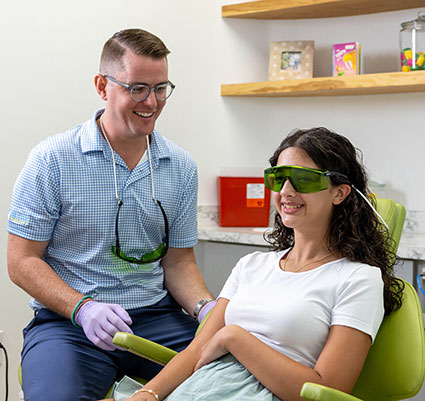Dental lasers are a gentle, less invasive way to effectively and safely remove soft tissue, most often gum tissue and muscle attachment points. Used in a variety of procedures, dental lasers offer precise treatment that is more comfortable and faster than traditional dental methods. For children, this means far less fear and anxiety and an overall better treatment experience.
Laser therapy provides the following advantages:
- Minimal Bleeding: As the dental laser vaporizes the tissue, the high-energy light beam aids in the clotting (coagulation) of exposed blood vessels, which reduces blood loss.
- Reduced Swelling and Discomfort: The dental laser seals the tissue, reducing the swelling and discomfort associated with traditional scalpel surgery. It also reduces the need for stitches.
- Less Risk of Infection: The sanitizing effect of the laser reduces the risk of infection, which results in faster healing.
- Improved Treatment Experience: The laser hand piece is quiet and doesn’t vibrate like traditional dental “drills.” This approach is gentle enough that anesthetic is usually not necessary.
Laser Treatment of Tongue- and Lip-Tie
Tongue-tie is a developmental abnormality of the tongue, which occurs when the lingual frenulum is too short, causing limited tongue movement. Lip-tie occurs when the upper lip is attached to the gum tissue above the front teeth. Both conditions have been associated with breastfeeding problems among newborns, as the defect may cause poor latch, inadequate feeding, and maternal nipple pain. Poor tongue mobility, speech, and gingival recession have also been related to tongue- and lip-tie.
Laser treatment of tongue- and lip-tie for infants is a procedure called a frenectomy. Treatment with a laser will not require stitches and only a minimal amount of topical and local anesthetic may be necessary.
Periodontal Treatments
While gum and periodontal disease are most often associated with adults, children are at risk to develop gum disease as well. In place of traditional scaling and root planing, which removes plaque and bacteria by scraping the teeth and roots below the gum line, we can remove the bacteria that cause gum disease through non-invasive laser periodontal therapy. When the bacterial deposits are removed, the gums will heal and begin to reattach to the teeth.
Uncovering Erupting Teeth to Prevent Impaction
At times, thick gum tissue may prevent an erupting tooth from coming in. This impaction often occurs with the canines, also known as cuspids or eyeteeth. Our use of laser dentistry allows us to quickly and precisely remove excess gum tissue with minimal or no bleeding, post-operative pain, or swelling. This lets erupting teeth come in unhindered, preventing impactions and infections, and may even lead to less crowding of the teeth.
Dental Extractions
While we practice a non-extraction policy whenever possible, there are times when it is best for your child’s oral health that a tooth be removed. Surprisingly, most of the pain and discomfort felt from an extraction is not in the procedure itself, but is due to swelling at the site of the removed tooth and any incisions. Soft-tissue lasers eliminate the need for incisions and stitches, which results in less swelling and inflammation.

